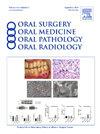Augmented intelligence in oral and maxillofacial radiology: a systematic review
IF 2
3区 医学
Q2 DENTISTRY, ORAL SURGERY & MEDICINE
Oral Surgery Oral Medicine Oral Pathology Oral Radiology
Pub Date : 2025-04-05
DOI:10.1016/j.oooo.2025.03.015
引用次数: 0
Abstract
Background
Artificial intelligence (AI) is transforming diagnostic imaging in dentistry. This systematic review evaluates existing literature on augmented intelligence in dentomaxillofacial radiology, focusing on its influence on human collaboration in interpreting dental imaging.
Study Design
A literature search across seven databases and gray literature was conducted. Studies evaluating clinician performance with AI-assistance were included, while reviews, surveys, and case reports were excluded. The QUADAS-2 tool assessed the risk of bias.
Results
Sixteen studies assessed the influence of AI on radiographic interpretation. AI-assisted caries detection consistently improved accuracy, sensitivity, and specificity. Detection of apical pathoses and jaw lesion segmentation improved accuracy, reducing diagnostic time. Cephalometric landmark identification showed increased accuracy, particularly for students. Soft tissue calcification detection improved accuracy, but sensitivity decreased. Overall, augmented intelligence enhanced interobserver agreement and reduced diagnostic variability, with general dentists and students showing the greatest gains.
Conclusions
Augmented intelligence enhances dental radiographic interpretation by improving tasks, particularly for less experienced clinicians, and positively influences clinical decision-making. However, AI performance remains inconsistent in challenging cases involving complex pathoses or varied imaging conditions. While it complements rather than replaces clinicians, further validation of AI's generalizability and reliability using larger, diverse datasets is necessary.
增强智能在口腔颌面放射学:一个系统的回顾。
背景:人工智能(AI)正在改变牙科诊断成像。本系统综述评估了牙颌面放射学中增强智能的现有文献,重点关注其对人类协作解释牙科成像的影响。研究设计:对七个数据库和灰色文献进行文献检索。评估临床医生在人工智能辅助下表现的研究被纳入,而综述、调查和病例报告被排除在外。QUADAS-2工具评估偏倚风险。结果:16项研究评估了人工智能对x线影像解释的影响。人工智能辅助龋齿检测不断提高准确性、灵敏度和特异性。根尖病变检测和颌骨病变分割提高了准确性,缩短了诊断时间。头颅标记识别的准确性有所提高,尤其是对学生而言。软组织钙化检测提高了准确性,但降低了灵敏度。总体而言,增强的智能增强了观察者之间的一致性,减少了诊断的可变性,普通牙医和学生表现出最大的收益。结论:增强智能通过改进任务,特别是对经验不足的临床医生,增强了牙科放射学解释,并积极影响临床决策。然而,在涉及复杂疾病或不同成像条件的挑战性病例中,人工智能的表现仍然不一致。虽然它是对临床医生的补充而不是取代,但有必要使用更大、更多样化的数据集进一步验证人工智能的普遍性和可靠性。
本文章由计算机程序翻译,如有差异,请以英文原文为准。
求助全文
约1分钟内获得全文
求助全文
来源期刊

Oral Surgery Oral Medicine Oral Pathology Oral Radiology
DENTISTRY, ORAL SURGERY & MEDICINE-
CiteScore
3.80
自引率
6.90%
发文量
1217
审稿时长
2-4 weeks
期刊介绍:
Oral Surgery, Oral Medicine, Oral Pathology and Oral Radiology is required reading for anyone in the fields of oral surgery, oral medicine, oral pathology, oral radiology or advanced general practice dentistry. It is the only major dental journal that provides a practical and complete overview of the medical and surgical techniques of dental practice in four areas. Topics covered include such current issues as dental implants, treatment of HIV-infected patients, and evaluation and treatment of TMJ disorders. The official publication for nine societies, the Journal is recommended for initial purchase in the Brandon Hill study, Selected List of Books and Journals for the Small Medical Library.
 求助内容:
求助内容: 应助结果提醒方式:
应助结果提醒方式:


